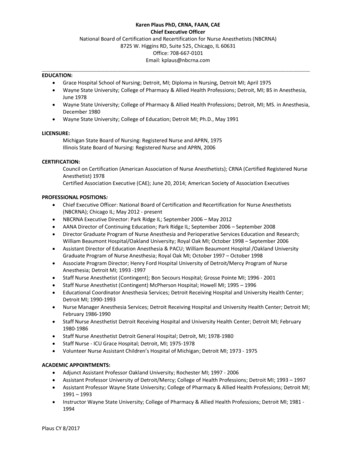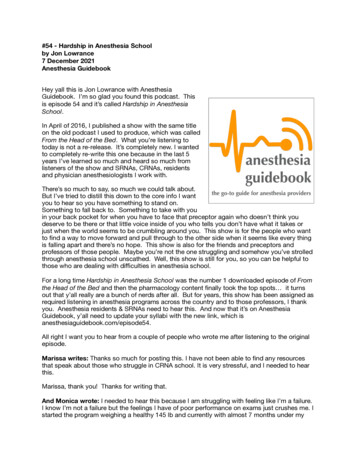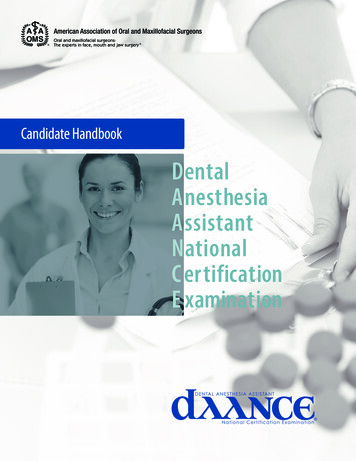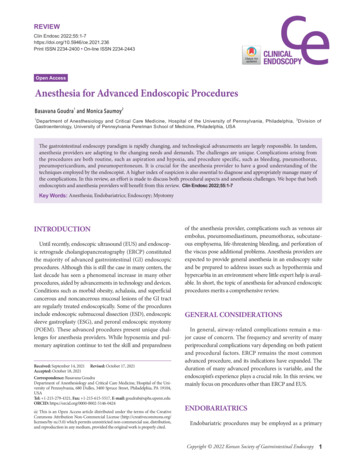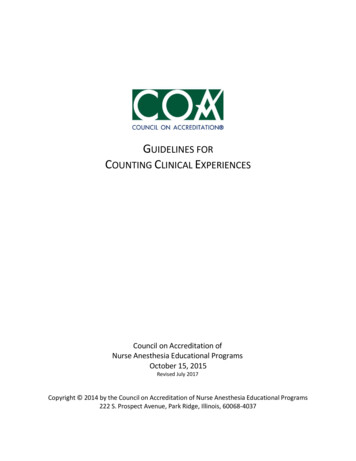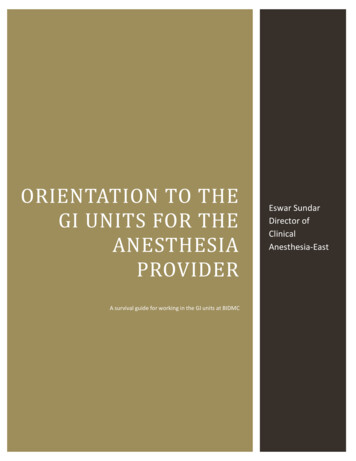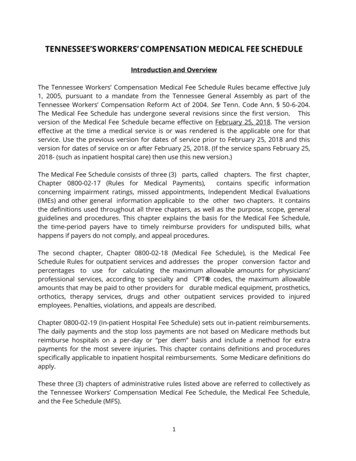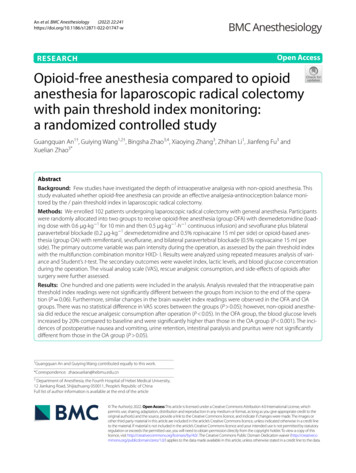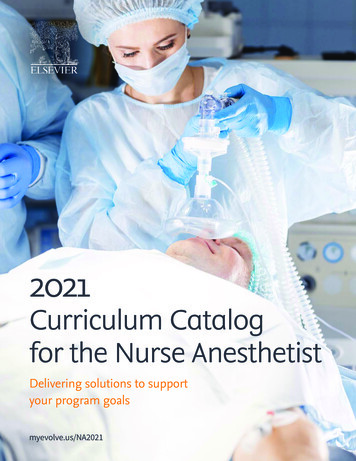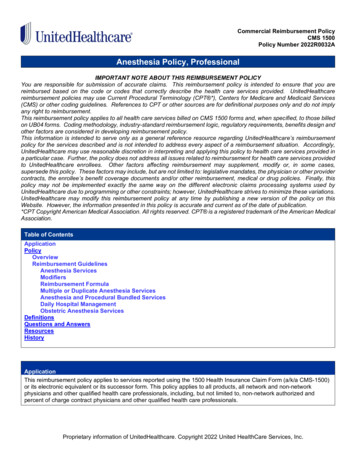
Transcription
Commercial Reimbursement PolicyCMS 1500Policy Number 2022R0032AAnesthesia Policy, ProfessionalIMPORTANT NOTE ABOUT THIS REIMBURSEMENT POLICYYou are responsible for submission of accurate claims. This reimbursement policy is intended to ensure that you arereimbursed based on the code or codes that correctly describe the health care services provided. UnitedHealthcarereimbursement policies may use Current Procedural Terminology (CPT *), Centers for Medicare and Medicaid Services(CMS) or other coding guidelines. References to CPT or other sources are for definitional purposes only and do not implyany right to reimbursement.This reimbursement policy applies to all health care services billed on CMS 1500 forms and, when specified, to those billedon UB04 forms. Coding methodology, industry-standard reimbursement logic, regulatory requirements, benefits design andother factors are considered in developing reimbursement policy.This information is intended to serve only as a general reference resource regarding UnitedHealthcare’s reimbursementpolicy for the services described and is not intended to address every aspect of a reimbursement situation. Accordingly,UnitedHealthcare may use reasonable discretion in interpreting and applying this policy to health care services provided ina particular case. Further, the policy does not address all issues related to reimbursement for health care services providedto UnitedHealthcare enrollees. Other factors affecting reimbursement may supplement, modify or, in some cases,supersede this policy. These factors may include, but are not limited to: legislative mandates, the physician or other providercontracts, the enrollee’s benefit coverage documents and/or other reimbursement, medical or drug policies. Finally, thispolicy may not be implemented exactly the same way on the different electronic claims processing systems used byUnitedHealthcare due to programming or other constraints; however, UnitedHealthcare strives to minimize these variations.UnitedHealthcare may modify this reimbursement policy at any time by publishing a new version of the policy on thisWebsite. However, the information presented in this policy is accurate and current as of the date of publication.*CPT Copyright American Medical Association. All rights reserved. CPT is a registered trademark of the American MedicalAssociation.Table of ContentsApplicationPolicyOverviewReimbursement GuidelinesAnesthesia ServicesModifiersReimbursement FormulaMultiple or Duplicate Anesthesia ServicesAnesthesia and Procedural Bundled ServicesDaily Hospital ManagementObstetric Anesthesia ServicesDefinitionsQuestions and AnswersResourcesHistoryApplicationThis reimbursement policy applies to services reported using the 1500 Health Insurance Claim Form (a/k/a CMS-1500)or its electronic equivalent or its successor form. This policy applies to all products, all network and non-networkphysicians and other qualified health care professionals, including, but not limited to, non-network authorized andpercent of charge contract physicians and other qualified health care professionals.Proprietary information of UnitedHealthcare. Copyright 2022 United HealthCare Services, Inc.
Commercial Reimbursement PolicyCMS 1500Policy Number 2022R0032APolicyOverviewUnitedHealthcare's reimbursement policy for anesthesia services is developed in part using the American Society ofAnesthesiologists (ASA) Relative Value Guide (RVG ), the ASA CROSSWALK , and Centers for Medicare andMedicaid Services (CMS) National Correct Coding Initiative (NCCI) Policy Manual, CMS NCCI edits and the CMSNational Physician Fee Schedule.Current Procedural Terminology (CPT ) codes and modifiers and Healthcare Common Procedure Coding System(HCPCS) modifiers identify services rendered. These services may include, but are not limited to, general or regionalanesthesia, Monitored Anesthesia Care, or other services to provide the patient the medical care deemed optimal.The Anesthesia Policy addresses reimbursement of procedural or pain management services that are an integral partof anesthesia services as well as anesthesia services that are an integral part of procedural services.Reimbursement GuidelinesAnesthesia ServicesAnesthesia services must be submitted with a CPT anesthesia code in the range 00100-01999, excluding 01953 and01996, and are reimbursed as time-based using the Standard Anesthesia Formula.For purposes of this policy the code range 00100-01999 specifically excludes 01953 and 01996 when referring toanesthesia services. CPT codes 01953 and 01996 are not considered anesthesia services because, according to theASA RVG , they should not be reported as time-based services.ModifiersRequired Anesthesia ModifiersAll anesthesia services including Monitored Anesthesia Care must be submitted with a required anesthesia modifier inthe first modifier position. These modifiers identify whether a procedure was personally performed, medically directed,or medically supervised. Consistent with CMS, UnitedHealthcare will adjust the Allowed Amount by the ModifierPercentage indicated in the table entageProvider typeAA100%Anesthesiologist MDPersonally PerformedAD100%Anesthesiologist MDSupervising over 4QK50%Anesthesiologist MDSupervising 2-4QX50%CRNA or AADirected by Anesthesiologist MDQY50%Anesthesiologist MDSupervising 1QZ100%CRNAPersonally PerformedPhysical Status ModifiersCPT and ASA guidelines identify six levels of ranking for patient physical status. Appending a physical status modifierto a time-based anesthesia code identifies the level of complexity and Modifying Unit(s) are added to the Base UnitProprietary information of UnitedHealthcare. Copyright 2022 United HealthCare Services, Inc.
Commercial Reimbursement PolicyCMS 1500Policy Number 2022R0032AValue for the most complex situations. If more than one physical status modifier (P3, P4, or P5) is submitted, themodifier with the highest number of units is the reimbursable service.PhysicalModifying UnitsStatusAdded to the BaseModifiersUnit ValueP10 unitsP20 unitsP31 unitP42 unitsP53 unitsThese CPT and HCPCS modifiers may be reported to identify an altered circumstance for anesthesia and painmanagement. If reporting CPT modifier 23 or 47 or HCPCS modifier GC, G8, G9 or QS then no additionalreimbursement is allowed above the usual fee for that 76XE77XP78XS79XUReimbursement FormulaBase Values:Each CPT anesthesia code (00100-01999) is assigned a Base Value by the ASA, and UnitedHealthcare uses thesevalues for determining reimbursement. The Base Value of each code is comprised of units referred to as the Base UnitValue.Time Reporting:Consistent with CMS guidelines, UnitedHealthcare requires time-based anesthesia services be reported with actualAnesthesia Time in one-minute increments. For example, if the Anesthesia Time is one hour, then 60 minutes shouldbe submitted.The ASA indicates that post- surgical pain blocks are frequently placed before anesthesia induction or after anesthesiaemergence. When the block is placed before induction or after emergence, the time spent placing the block should notbe added to the reported anesthesia time; this is true even if sedation and monitoring is provided to the patient duringblock placement.Reimbursement Formulas:Time-based anesthesia services are reimbursed according to the following formulas:Standard Anesthesia Formula without Modifier AD* ([Base Unit Value Time Units Modifying Units] xConversion Factor) x Modifier Percentage.Standard Anesthesia Formula with Modifier AD* ([Base Unit Value of 3 1 Additional Unit if anesthesia notesindicate the physician was present during induction] x Conversion Factor) x Modifier Percentage.*For additional information, Refer to Modifiers.Proprietary information of UnitedHealthcare. Copyright 2022 United HealthCare Services, Inc.
Commercial Reimbursement PolicyCMS 1500Policy Number 2022R0032AQualifying CircumstancesQualifying circumstances codes identify conditions that significantly affect the nature of the anesthetic service provided.Qualifying circumstances codes should only be billed in addition to the anesthesia service with the highest Base UnitValue. The Modifying Units identified by each code are added to the Base Unit Value for the anesthesia serviceaccording to the above Standard Anesthesia Formula.ProcedureCodeModifying Units99100Per the ASA RVG an additional unit for 99100 is not allowed with anesthesiacodes 00326, 00561, 00834 and 008361 unit99116Per the ASA RVG additional units for 99116 are not allowed with anesthesiacodes 00561, 00562, 00563 and 005675 units99135Per the ASA RVG additional units for 99135 are not allowed with anesthesiacodes 00561, 00562, 00563 and 005675 units99140An emergency is defined as existing when delay in treatment of the patientwould lead to a significant increase in the threat to life or body part2 unitsAdditional Information:Anesthesia when surgery has been cancelled – Refer to the Questions and Answers section, Q&A #3, for additionalinformation.For information on reporting Certified Registered Nurse Anesthetist (CRNA) services, refer to the Questions andAnswers section, Q&A #4.Multiple or Duplicate Anesthesia ServicesMultiple Anesthesia Services:According to the ASA, when multiple surgical procedures are performed during a single anesthesia administration, onlythe single anesthesia code with the highest Base Unit Value is reported. The time reported is the combined total for allprocedures performed on the same patient on the same date of service by the same or different physician or otherqualified health care professional. Add-on anesthesia codes (01953, 01968 and 01969) are exceptions to this and areaddressed in the Anesthesia Services section and Obstetric Anesthesia Services section of this policy.UnitedHealthcare aligns with these ASA coding guidelines. Specific reimbursement percentages are based on theanesthesia modifier(s) reported.Duplicate Anesthesia Services:When duplicate (same) anesthesia codes are reported by the same or different physician or other qualified health careprofessional for the same patient on the same date of service, UnitedHealthcare will only reimburse the first submissionof that code. However, anesthesia administration services can be rendered simultaneously by an MD and a CRNAduring the same operative session, each receiving 50% of the Allowed Amount (as indicated in the Modifier Tableabove) by reporting modifiers QK or QY and QX.In the event an anesthesia administration service is provided during a different operative session on the same day as aprevious operative session, UnitedHealthcare will reimburse one additional anesthesia administration appended withmodifier 59, 76, 77, 78, 79 or XE. As with the initial anesthesia administration, only the single anesthesia code with thehighest Base Unit Value should be reported.Anesthesia and Procedural Bundled ServicesUnitedHealthcare sources anesthesia edits to methodologies used and recognized by third party authorities (referencedin the Overview section) when considering procedural or pain management services that are an integral part ofanesthesia services, and anesthesia services that are an integral part of procedural or pain management services.Those methodologies can be Definitive or Interpretive. A Definitive source is one that is based on very specificinstructions from the given source. An Interpreted source is one that is based on an interpretation of instructions fromProprietary information of UnitedHealthcare. Copyright 2022 United HealthCare Services, Inc.
Commercial Reimbursement PolicyCMS 1500Policy Number 2022R0032Athe identified source (see the Definitions section below for further explanations of these sources). Where CMS NCCIedits exist these edits are managed under the UnitedHealthcare “CCI Editing Policy”.Procedural/pain management services or anesthesia services that are identified as bundled (integral) are notseparately reimbursable when performed by the Same Individual Physician or Other Qualified Health Care Professionalon the same date of service. The Same Individual Physician or Other Qualified Health Care Professional is defined asthe same individual rendering health care services reporting the same Federal Tax Identification number.Procedural or Pain Management Services Bundled in Anesthesia Services: Services in the CMS National Physician Fee Schedule that have a status indicator of B (Bundled code) or T(Injections); Services that are not separately reimbursed with anesthesia services as stated in the CMS NCCI Policy Manual,Chapter 2 although they are not specifically listed in that manual: 64561, 82800, 82803, 82805, 82810, 85345, 85347,85348; Nerve Block codes billed in conjunction with anesthesia services when modifier 59, XE or XU is not appended to thenerve block codeThe above CPT and HCPCS codes are included in the following list:Procedural or Pain Management Codes Bundled into 64489645208280599056The CMS NCCI Policy manual states that "many standard preparation, monitoring, and procedural services areconsidered integral to the anesthesia service. Although some of the services would never be appropriately reported onthe same date of service as anesthesia management, many of these services could be provided at a separate patientencounter unrelated to the anesthesia management on the same date of service." Anesthesia Professionals mayidentify these separate encounters by reporting a modifier 59, XE or XU. For CPT and HCPCS codes included on theProcedural or Pain Management Codes Bundled into Anesthesia list that will be considered distinct procedural serviceswhen modifier 59, XE or XU is appended, refer to the following list:Procedural or Pain Management Bundled Codes Allowed with 4463644916456185345Anesthesia Services Bundled in Procedural Services:According to the NCCI Policy Manual, Chapter 1, CMS does not allow separate payment for anesthesia servicesperformed by the physician who also furnishes the medical or surgical procedure, excluding Moderate Sedation. InProprietary information of UnitedHealthcare. Copyright 2022 United HealthCare Services, Inc.
Commercial Reimbursement PolicyCMS 1500Policy Number 2022R0032Athese situations, the allowance for the anesthesia service is included in the payment for the medical or surgicalprocedure. In addition, AMA states “if a physician personally performs the regional or general anesthesia for a surgicalprocedure that he or she also performs, modifier 47 would be appended to the surgical code, and no codes from theanesthesia section would be used.”UnitedHealthcare will not separately reimburse an anesthesia service when reported with a medical or surgicalprocedure (where the anesthesia service is the direct or alternate crosswalk code for the medical or surgical procedure)submitted by the Same Individual Physician or Other Qualified Health Care Professional for the same patient on thesame date of service. For medical/surgical procedures reported using CPT codes, the direct and alternate crosswalkanesthesia codes are obtained from the ASA CROSSWALK . For medical/surgical procedures reported as HCPCScodes, the direct and alternate crosswalk anesthesia codes are obtained from CMS NCCI edits and interpretation ofother CMS sources.Anesthesia Services Bundled into HCPCS Procedural 0196600300001600063000800Proprietary information of UnitedHealthcare. Copyright 2022 United HealthCare Services, Inc.
Commercial Reimbursement PolicyCMS 1500Policy Number 2022R0032ARefer to the publication ASA CROSSWALK for a listing of medical or surgical procedures and the correspondingdirect or alternate crosswalk anesthesia service.Refer to the Questions and Answers section, Q&A #1 and #2 for additional information.Preoperative/Postoperative VisitsConsistent with CMS, UnitedHealthcare will not separately reimburse an E/M service; CPT codes 99091, 99202-99499(excluding critical care CPT codes 99291-99292) and 92004-92014 when reported by the Same Specialty Physician orOther Qualified Health Care Professional on the same date of service as an anesthesia service.Critical care CPT codes 99291-99292 are not considered included in an anesthesia service and will be separatelyreimbursed.The Same Specialty Physician or Other Qualified Health Care Professional is defined as physicians and/or otherqualified health care professionals of the same group and same specialty reporting the same Federal Tax Identificationnumber.Daily Hospital ManagementDaily hospital management of epidural or subarachnoid drug administration (CPT code 01996) in a CMS place ofservice 19 (off campus outpatient hospital), 21 (inpatient hospital), 22 (on campus outpatient hospital) or 25 (birthingcenter) is a separately reimbursable service once per date of service excluding the day of insertion. CPT code 01996 isconsidered included in the pain management procedure if submitted on the same date of service by the SameIndividual Physician or Other Qualified Health Care Professional.If the anesthesiologist continues with the patient's care after discharge, the appropriate Evaluation and Managementcode should be used.Obstetric Anesthesia ServicesNeuraxial Labor Analgesia Reimbursement CalculationsConsistent with a method described in the ASA RVG UnitedHealthcare will reimburse neuraxial labor analgesia (CPTcode 01967) based on Base Unit Value plus Time Units subject to a cap of 435 minutes. Modifying Units for physicalstatus modifiers and qualifying circumstance codes will be considered in addition to the Base Unit Value for labor ordelivery anesthesia services in accordance with the Standard Anesthesia Formula (refer to the ReimbursementFormula section of the policy above).Obstetric Add-On CodesObstetric Anesthesia often involves extensive hours and the transfer of anesthesia to a second physician. Due to theseunique circumstances, UnitedHealthcare will consider for reimbursement, add-on CPT codes 01968 and 01969 (csection anesthesia) when billed with the primary CPT code 01967 (by the same or different individual physician or otherqualified healthcare professional) for the same member. According to the ASA Crosswalk time for add-on code 01968or 01969 is reported separately as a surgical anesthesia service and is not added to the time reported for the laboranesthesia service.Obstetric Anesthesia: Neuraxial Labor Analgesia Reimbursement CalculationsExample 1: 200 minutes are reported for labor and delivery services on a single claim line with CPT code 01967: Thetotal 200 minutes will be added to the Base Unit Value for CPT code 01967.Example 2: 500 minutes are reported for labor and delivery services on a single claim line with CPT code 01967: Acapped 435 minutes will be added to the Base Unit Value for CPT code 01967.Example 3: Labor and delivery services are reported on multiple claim lines with CPT code 01967 at 200 minutes andadd-on CPT code 01968 at 75 minutes: 200 minutes will be added to the Base Unit Value for CPT code 01967 and 75minutes will be added to the Base Unit Value for CPT code 01968.Example 4: Labor and delivery services are reported on multiple claim lines with CPT code 01967 at 700 minutes, addon CPT code 01968 at 75 minutes, and qualifying circumstance code 99140: A capped 435 minutes for CPT code01967 and 30 minutes for qualifying circumstance code 99140 will be added to the Base Unit Value for CPT code01967 and 75 minutes will be added to the Base Unit Value for CPT code 01968.Proprietary information of UnitedHealthcare. Copyright 2022 United HealthCare Services, Inc.
Commercial Reimbursement PolicyCMS 1500Policy Number 2022R0032ADefinitionsAllowable AmountAnesthesia ProfessionalAnesthesia TimeBase Unit ValueBase ValueConversion FactorDefinitive SourceInterpretive SourceModerate SedationModifier PercentageModifying UnitsMonitored Anesthesia CareDefined as the dollar amount eligible for reimbursement to the physician orother qualified health care professional on the claim. Contracted rate,reasonable charge, or billed charges are examples of an Allowable Amount,whichever is applicable. For percent of charge or discount contracts, theAllowable Amount is determined as the billed amount, less the discount.An Anesthesiologist, a Certified Registered Nurse Anesthetist (CRNA),Anesthesia Assistant (AA), or other qualified individual working independentlyor under the medical supervision of a physician.Anesthesia Time begins when the Anesthesia Professional prepares thepatient for the induction of anesthesia in the operating room or in anequivalent area (i.e. a place adjacent to the operating room) and ends whenthe Anesthesia Professional is no longer in personal attendance and when thepatient may be safely placed under postoperative supervision. AnesthesiaTime involves the continuous actual presence of the Anesthesia Professional.The number of units which represent the Base Value (per code) of all usualanesthesia services, except the time actually spent in anesthesia care andany Modifying Units.The Base Value includes the usual preoperative and postoperative visits, theadministration of fluids and/or blood products incident to the anesthesia care,and interpretation of non-invasive monitoring (ECG, temperature, bloodpressure, oximetry, capnography, and mass spectrometry). Placement ofarterial, central venous and pulmonary artery catheters and use oftransesophageal echocardiography (TEE) are not included in the Base Value.The incremental multiplier rate defined by specific contracts or industrystandards. For non-network physicians the applied Conversion Factor isbased on a recognized national source.Definitive Sources contain the exact codes, modifiers or very specificinstructions from the given source.An edit source that includes guidelines; however, no exact or specific code ormodifier information is listed. Therefore, an interpretation must be made as towhat codes correlate to the guidelines. Additionally, an interpretation may beapplied to surrounding or similar codes based on related definitively sourcededits.Moderate (conscious) Sedation is a drug-induced depression ofconsciousness during which patients respond purposefully to verbalcommands, either alone or accompanied by light tactile stimulation. Nointerventions are required to maintain a patent airway, and spontaneousventilation is adequate. Cardiovascular function is usually maintained.Moderate Sedation does not include minimal sedation (anxiolysis), deepsedation, or monitored anesthesia care (CPT codes 00100-01999).Reimbursement percentage allowed for anesthesia services which arepersonally performed, medically directed or medically supervised as definedby the modifier (i.e. 50% for the modifier QK).Time Units added for additional reimbursement allowed as defined by thephysical status modifier or qualifying circumstances codes reported (i.e. Oneadditional unit added to the Base Unit Value for appending modifier P3).Per the ASA Monitored Anesthesia Care includes all aspects of anesthesiacare – a preprocedure visit, intraprocedure care and postprocedureanesthesia management. During Monitored Anesthesia Care, theanesthesiologist provides or medically directs a number of specific services,including but not limited to: Diagnosis and treatment of clinical problems that occur during theprocedureProprietary information of UnitedHealthcare. Copyright 2022 United HealthCare Services, Inc.
Commercial Reimbursement PolicyCMS 1500Policy Number 2022R0032ASupport of vital functionsAdministration of sedatives, analgesics, hypnotics, anestheticagents or other medications as necessary for patient safety Psychological support and physical comfort Provision of other medical services as needed to complete theprocedure safely.Monitored Anesthesia Care may include varying levels of sedation, analgesiaand anxiolysis as necessary. The provider of Monitored Anesthesia Care mustbe prepared and qualified to convert to general anesthesia when necessary. Same Individual Physician or OtherQualified Health Care ProfessionalSame Specialty Physician or OtherQualified Health Care ProfessionalStandard Anesthesia FormulaTime UnitsModifiers G8, G9 and QS are used to identify Monitored Anesthesia Care.The same individual rendering health care services reporting the sameFederal Tax Identification number.Physicians and/or other qualified health care professionals of the same groupand same specialty reporting the same Federal Tax Identification number.Refers to either the Standard Anesthesia Formula with Modifier AD or theStandard Anesthesia Formula without Modifier AD, as appropriate. See theReimbursement Formula section of this policy for descriptions of those terms.The derivation of units based on time reported which is divided by a timeincrement generally of 15 minutes.Note: Consistent with CMS guidelines, UnitedHealthcare requires time-basedanesthesia services be reported with actual Anesthesia Time in one-minuteincrements.Questions and Answers12Q: How should anesthesia services performed by the Anesthesia Professional be reported when the medical orsurgical procedure is performed by a different physician or other qualified health care professional?A: For general or monitored anesthesia services, in support of a non-anesthesia service, please refer to the ASACROSSWALK and report the appropriate CPT anesthesia code (00100 - 01999).Q: How should anesthesia services performed by the same physician who also furnishes the medical or surgicalprocedure be reported?A: If a physician personally performs the anesthesia for a medical or surgical procedure that he or she alsoperforms, modifier 47 would be appended to the medical or surgical code, and no codes from the anesthesiasection of the CPT codebook would be used.Q: How should anesthesia services be reported when surgery has been cancelled?3A: If surgery is cancelled after the Anesthesia Professional has performed the preoperative examination but beforethe patient has been prepared for the induction of anesthesia, report the appropriate Evaluation & Managementcode for the examination only. If surgery is cancelled after the Anesthesia Professional has prepared the patientfor induction, report the most applicable anesthesia code with full base and time. The Anesthesia Professional isnot required to report the procedure as a discontinued service using modifier 53.Q: How should a CRNA report anesthesia services?4A: CRNA services should be reported with the appropriate anesthesia modifier QX or QZ. CRNA services must bereported under the supervising physician's name or the employer or entity name under which the CRNA iscontracted. In limited circumstances, when the CRNA is credentialed and/or individually contracted byUnitedHealthcare, CRNA services must be reported under the CRNA's name.Q: How should a teaching anesthesiologist report anesthesia services for two resident cases?5A: Consistent with CMS policy, the teaching anesthesiologist may report the actual Anesthesia Time (seedefinitions) for each case with modifiers AA and GC.Proprietary information of UnitedHealthcare. Copyright 2022 United HealthCare Services, Inc.
Commercial Reimbursement PolicyCMS 1500Policy Number 2022R0032A6Q: CPT code 01967 (Neuraxial labor analgesia/anesthesia for planned vaginal delivery) is performed by anAnesthesia Professional for a single anesthetic administration. CPT code 00851 (Anesthesia for intraperitonealprocedures in the lower abdomen including laparoscopy; tubal ligation/transection) is subsequently performed bythe same Anesthesia Professional during a separate operative session with a single anesthetic administration onthe same date of service for the same patient. How should the anesthesia services be reported?A: Report CPT code 01967 with the appropriate anesthesia modifier and time. Report CPT code 00851 with theappropriate anesthesia modifier and ti
These CPT and HCPCS modifiers may be reported to identify an altered circumstance for anesthesia and pain management. If reporting CPT modifier 23 or 47 or HCPCS modifier GC, G8, G9 or QS then no additional reimbursement is allowed above the usual fee for that service. CPT Modifiers HCPCS Modifiers . 22 GC 23 G8 47 G9 59 QS
